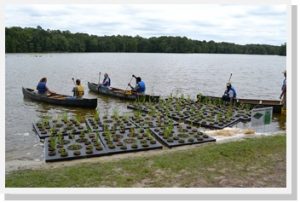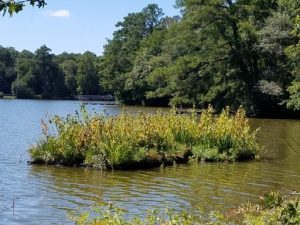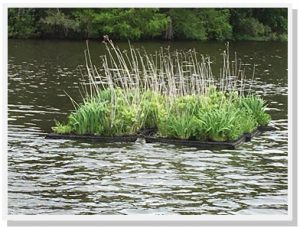
Facebook Twitter Instagram YouTube RSS Feed
Written on: May 24th, 2017 in Outreach

The Delaware Youth Conservation Corps preparing to install floating wetlands at Trap Pond State Park.
We’ve all heard about wetlands before but have you ever heard of a floating wetland?
Floating wetlands are artificial islands with plants on top and roots below. Similar to a natural wetland, they improve water quality by soaking up nutrients, such as nitrogen and phosphorus. These two nutrients are the primary causes of algal blooms, which make it difficult for fish and other aquatic life to survive.
Every time it rains, pollutants from lawns, roads, and other surfaces are swept into our waterways. Fortunately, we’re able to battle this runoff with floating wetlands, an efficient tool for cleaning polluted water. As the plants of the wetlands grow, they remove nutrient pollution and store it in their leaves while adding life-giving oxygen to the water. At the same time, their roots provide a home for microorganisms that feed on pollution.
The only element needed for all this to work? Simple sunlight.

Floating wetland in the fall of season 2.
In 2015 DNREC purchased twelve floating rafts and native plants which were then linked together to form two groups of floating wetlands. The Delaware Youth Conservation Corps installed the two wetlands at Trap Pond during the Nanticoke Watershed Alliance’s annual Wade In and Nanticoke River Report Card Release event. Since then, it’s been a huge hit, not only for the students who got to install them, but also for everyone else at the park that couldn’t wait to hop in a kayak and paddle out to see them.
Over the past couple years, the wetlands have flourished and have been a destination point not only for curious paddlers but also for fisherman hoping to catch one of the many fish that find habitat in the cooler cleaner water below the raft’s root system.
Luckily, the geese have not been interested in joining in the fun. If that had occurred, there were certain plants that would have been added to deter them as well as other techniques that would have been put in place but proved not to be necessary. The turtles on the other hand, call it home –finding food and a place to sunbathe.

Floating wetland in the spring of season 3.
Due to the huge size of the pond, water quality improvement was not the intention of this project. This is simply a demonstration project that provides an opportunity for people to see what they are and learn about how they work.
Trap Pond is an ideal setting, not only because of the traffic through the park –the fisherman, paddlers, boaters, hikers, campers, students and anyone who passes them, but also because of the accessibility. To be able to paddle out and get a close up look at exactly how it’s working has been enjoyed and appreciated by the park’s visitors since the day they were installed. They’ve since been added as an educational component of the pontoon tours and canoe and kayak trips.
Stop by Trap Pond to see their progress this summer!